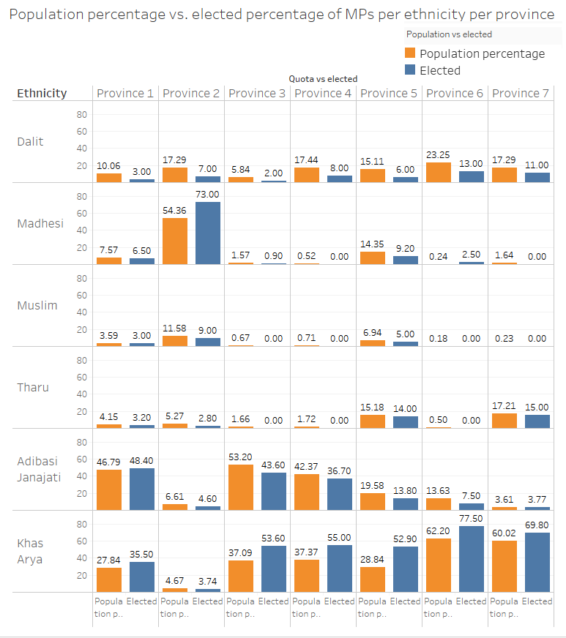
News Analysis
4 MIN READ


Of 550 total seats in provincial assemblies, Khas Arya won 243 seats (44 percent), Madhesi won 94 (17 percent), Muslims won 17 (3 percent), Dalits won 33 (6 percent) Adibasi Janajatis won 137 (25 percent) and Tharus won 26 seats (5 percent). Overall, Khas Arya and Madhesis are over-represented in comparison to their population, while Dalits, Adibasi Janajatis, and Muslims are under-represented. The charts below show a detailed picture of the composition of provincial assemblies by ethnicity and gender.
Click each graph to view higher resolution interactive versions.
In fig. II we see a contrast between Province 1, 2 and the remaining provinces; they are the only provinces where Khas Arya do not form the biggest block of MPs. In Province 1, Adibasi Janajatis make up 48 percent of the MPs, and Khas Arya are close behind, with 35 percent. Province 2 is unique in having a clear Madhesi majority (72 percent).
The reason of higher representation of Janajatis and Madhesis, analysts say, could be because of strong identity-based movement. However, this has not resulted in greater representation of Dalits. For example, in the three election results after 2008, Madhes-based parties’ inclusion of Madhesi Dalits is not different than that of UML, NC and others. Rastriya Janata Party Nepal has zero Dalit member in the assembly in this province while FSFN party has two Dalit lawmakers in province 2. Similarly, in Province 7, which also witnessed the Tharu movement and was the site of Akhanda Sudurpaschim movement, has no representation of Dalits in its assembly.

There are almost twice as many male MPs as female ones in every province. Only 6 female candidates won through the FPTP, and the rest were elected through PR. Much like the pigeonholing of female candidates to deputy positions in the local elections, Nepal’s political parties had assigned the bulk of their female candidates to the PR roster.
According to Nepali Congress politician Pushpa Bhusal, the problem began with the candidacies in the FPTP system. “The parties’ structure itself is male-dominant. Women candidacy recommendation was low as male members dominate party’s rank and file,” Bhusal said.
“The so-called senior leaders are not psychologically prepared to accept Dalit or Women leadership.” Bhusal said. An illustrative case from the local elections held earlier in the year: a section of Congress leaders lobbied against the candidacy of Nripa Oda when the party proposed him as mayoral candidate of Dhangadhi Sub-metropolitan city arguing non-Dalit will have to offer Namaste to a Dalit if he gets elected mayor.
Yam Bahadur Kisan, inclusion scholar and professor at Tribhuvan University, also stated that Dalit leaders are still not accepted in society, and Dalits were excluded in the nominations.
Women constitute 33 percent of all the provincial assembly members put together, and Dalit representation is just six percent.
A party-wise comparison of gender shows that the leading party, UML, has the widest gap between the number of male and female elected MPs: 68% of their elected representatives are male. Women are underrepresented in the Maoists, NC and SSF as well.
In terms of ethnicity of MPs across parties, the divide is clear. Khas Arya representatives make up 56% of UML’s MPs, 50% of Maoist MPs, and 34% of NC MPs. Adibasi Janajati MPs are distributed mainly among UML, Maoist-Center and NC. RJP and SSF have clear Madhesi majorities; these parties have the most minimal MPs of other ethnicities.
It costs a lot to fight elections
The growing expenses in electioneering have also discouraged Dalits and women from contesting the elections. Some Dalits refused to contest elections due to lack of funds, and the parties also prioritized rich politicians during nominations.
“The EC made laws to control the election expenses but failed to set up mechanisms to control excesses,” said Pushpa Bhusal. “Women and Dalits suffer the most due to a lack of such mechanism.”
Quota to Khas Arya
The constitution has allocated quota seats to Khas Arya, an already over-represented group. This comes at the expense of the representation of Dalits and others. According to Mukta Lama, an expert on inclusion, reservation of Khas Arya in the proportional electoral system was not necessary since the system was designed to ensure representation of those under-represented under the FPTP system.
“Electoral system needs to be revised”
According to Pushpa Bhusal, it is essential to revise electoral system to increase the representation of Dalit, women, and other marginalized groups.
“We should adopt fully proportional electoral system. Only that can ensure representation of all cast and communities in state mechanisms,” Bhusal said.
Yam Bahadur Kisan suggested that a full proportional electoral system, or one where certain constituencies are reserved for women and Dalits, as it is practiced in India, could increase the representation of such marginalized groups.

Features
2 min read
The biggest group in Province 2, Dalits will occupy almost zero positions of power in the local government.
Features
5 min read
The ruling party’s top leaders have finally come to a truce, but the peace probably won’t last
Features
5 min read
Despite elaborate provisions on including persons with disabilities in political and public life in Nepal, political participation by persons with disabilities remains minimal.
News Analysis
4 min read
COVID19
Features
5 min read
Vaccinating Nepalis will cost billions of rupees, but the Oli government would rather divert government funds towards election preparations
Perspectives
10 min read
Patriarchy alone is not a sufficient explanation for the lack of women in candidate selection for the recently held local elections.
News
4 min read
Oli has effectively become a caretaker prime minister and will need to make way for a new government. But is the political drama prudent in the midst of a pandemic?